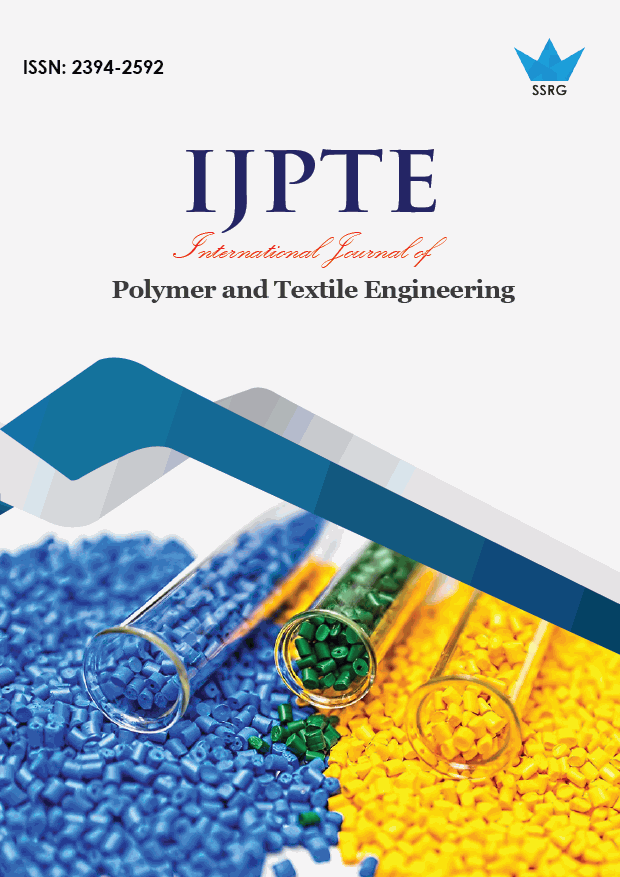Investigation of Combined Desizing, Scouring and Bleaching Effect with H2O2

| International Journal of Polymer and Textile Engineering |
| © 2019 by SSRG - IJPTE Journal |
| Volume 6 Issue 1 |
| Year of Publication : 2019 |
| Authors : Mafzal Ahmed, Jahirul Alam Chowdhury, Sibgatullah Shovon, Sheikh Sha Alam, Champa Saha, Md. Dulal Hosen, Tarikul Islam |
How to Cite?
Mafzal Ahmed, Jahirul Alam Chowdhury, Sibgatullah Shovon, Sheikh Sha Alam, Champa Saha, Md. Dulal Hosen, Tarikul Islam, "Investigation of Combined Desizing, Scouring and Bleaching Effect with H2O2," SSRG International Journal of Polymer and Textile Engineering, vol. 6, no. 1, pp. 10-18, 2019. Crossref, https://doi.org/10.14445/23942592/IJPTE-V6I1P103
Abstract:
The aim of this project is to investigate the com-bined desizing, scouring, and bleaching effect with H2O2. Now the world textile trade arena has been very competitive and tough. For a profitable textile business and for a high market share one needed to produce high quality textile with minimum cost and time. For all such requirements, it must be met against economic constraints relating to the cost of water, labor, plant, chemicals and energy. The first water is particularly the most important. A pretreat-ment process is the heart of textile. Pretreatment processes include desizing, scouring & bleaching which makes subsequent dyeing and soften processes easy. Uneven desizing, scouring and bleaching in pretreatment processes might cause drastic deteri-oration in the quality of processed products. The main innovation of the project lies in the combination of two or more continuous pretreatment processes in a single step, as would be the desizing, scouring and bleaching ,it has been tried to eliminate the process desizing by a combine scouring and bleaching bath with a high content of H2O2. The aim is to bring same color effect by this combine bath and regular indi-vidual bath (desizing, scouring and bleaching). This project was performed with two portions. One was as regular pretreatment processes (enzyme desizing, scouring and bleaching individually) and a combine
bath of scouring and bleaching with high H2O2. Then these two samples were dyed in same condition. The difference of this two determined the project fate. And differences were evaluated by color difference, ref-lectance index, whiteness, strength, absorbency, rub-bing fastness and weight loss.
Keywords:
Pretreatment, Desizing, Scouring, Bleaching, Enzyme, H2O2.
References:
[1] Mamun M. H. A., Hossain M. A., Ahmed M. K, Hossain M., F., Ali R., Yeasmin M. S., Rahman L., (2017) Effect of Different Types Scouring against Different Types of Bleaching Process on Dyeing of Cotton Fabric with Mo-nochlorotriazine (Hot Brand) Reactive Dye, International Journal of Textile Science, 6(5): 128-134.
[2] Wasif A. I., Indi, Y. M. (2010) Combined scouring-bleaching of cotton using potassium persulphate, NISCAIR-CSIR, In-dia, 35(2010), 353-357.
[3] Gulrajani M. L, Venkatraj R. Chandrasekaran P. (1987) A process for the combined scouring and bleaching of polyest-er/cotton fabrics at low temperature, 103(9), 299-303.
[4] Khalid N., and Thoburn J., (2004) Challenges To Vietnamese ISSN: 2394 – 2592 http://www.internationaljournalssrg.org Page 18 Firms In The World Garment And Textile Value Chain, And The Implications For Alleviating Poverty, Journal of the Asia Pacific Economy 9(2), 249–267.
[5] Vigo T. L., Textile Processing And Properties: Preparation, Dyeing, Finishing And Performance, Vol.11 (Elsevier Publi-cations, New York), 1997.
[6] Samna T. S., Mittal R. M. & Narasimham T., Text Res J, 59 (1989) 748. 3 Gulrajni M L & Sukumar N, J Soc Dyers Co-lour, 10(1985) 101.
[7] Gulrajni M. L., Colourage, 19 (1989) 36.
[8] Norms for Textile Industry (Atira Publication, Ahmadabad), March, 1982, E-11.
[9] Chattopadhyay D. P., Sharma J. K. & Chavan R. B., (1999)
Indian J Fibre Text Res, 24 (2), 120.
[10] El-Rafie M. H., Abdel Hafiz S. A., El-Sisi F F, Helmy M. & Hebeish A., Am Dyest Rep, 80(1) (1991) 45.
[11] Paul D., Das S. C., Islam T., Siddiquee M. A. B., Mamun M. A. A. (2017) Effect of Temperature on Dyeing Cotton Knit-ted Fabrics with Reactive Dye, Journal of Scientific and En-gineering Research, 4(12):388-393.
[12] http://www.dysin.com/
[13] http://www.aatcc.org/testing/index.htm
[14] http://www.fibre2fashion.com

 10.14445/23942592/IJPTE-V6I1P103
10.14445/23942592/IJPTE-V6I1P103